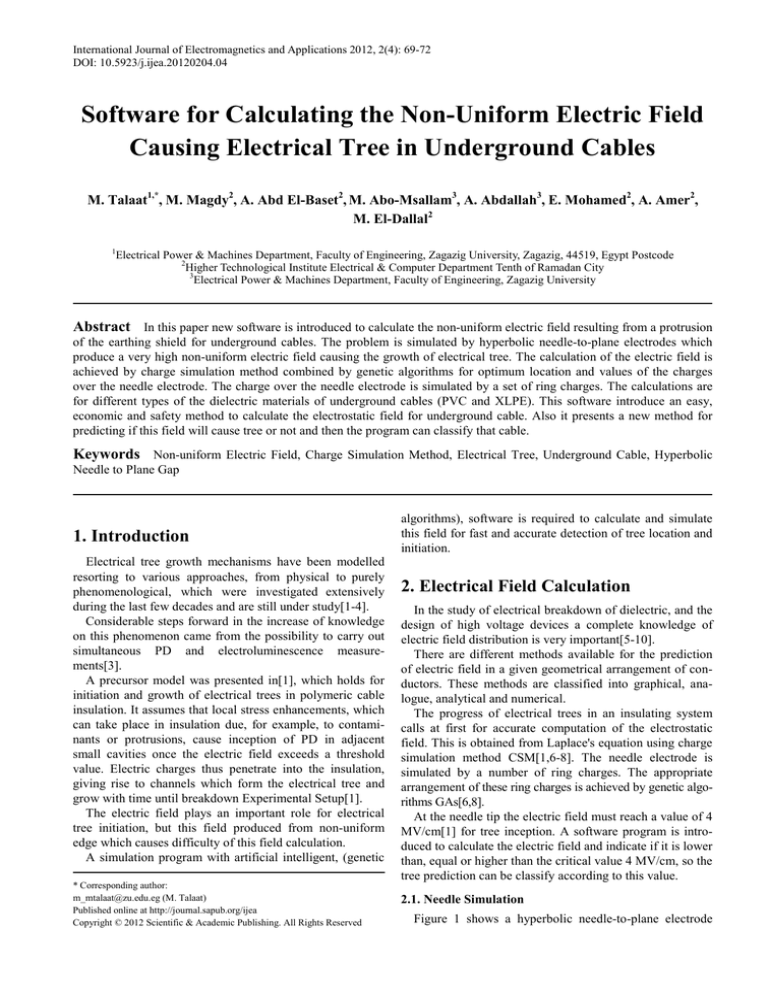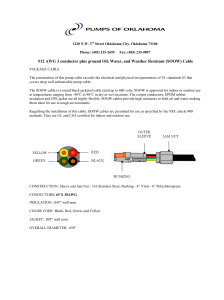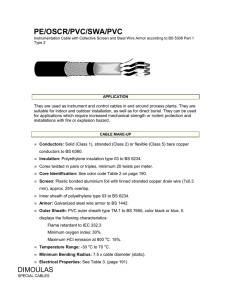
International Journal of Electromagnetics and Applications 2012, 2(4): 69-72
DOI: 10.5923/j.ijea.20120204.04
Software for Calculating the Non-Uniform Electric Field
Causing Electrical Tree in Underground Cables
M. Talaat1,*, M. Magdy2, A. Abd El-Baset2, M. Abo-Msallam3, A. Abdallah3, E. Mohamed2, A. Amer2,
M. El-Dallal2
1
Electrical Power & Machines Department, Faculty of Engineering, Zagazig University, Zagazig, 44519, Egypt Postcode
2
Higher Technological Institute Electrical & Computer Department Tenth of Ramadan City
3
Electrical Power & Machines Department, Faculty of Engineering, Zagazig University
Abstract In this paper new software is introduced to calculate the non-uniform electric field resulting from a protrusion
of the earthing shield for underground cables. The problem is simulated by hyperbolic needle-to-plane electrodes which
produce a very high non-uniform electric field causing the growth of electrical tree. The calculation of the electric field is
achieved by charge simulation method combined by genetic algorithms for optimum location and values of the charges
over the needle electrode. The charge over the needle electrode is simulated by a set of ring charges. The calculations are
for different types of the dielectric materials of underground cables (PVC and XLPE). This software introduce an easy,
economic and safety method to calculate the electrostatic field for underground cable. Also it presents a new method for
predicting if this field will cause tree or not and then the program can classify that cable.
Keywords Non-uniform Electric Field, Charge Simulation Method, Electrical Tree, Underground Cable, Hyperbolic
Needle to Plane Gap
1. Introduction
Electrical tree growth mechanisms have been modelled
resorting to various approaches, from physical to purely
phenomenological, which were investigated extensively
during the last few decades and are still under study[1-4].
Considerable steps forward in the increase of knowledge
on this phenomenon came from the possibility to carry out
simultaneous PD and electroluminescence measurements[3].
A precursor model was presented in[1], which holds for
initiation and growth of electrical trees in polymeric cable
insulation. It assumes that local stress enhancements, which
can take place in insulation due, for example, to contaminants or protrusions, cause inception of PD in adjacent
small cavities once the electric field exceeds a threshold
value. Electric charges thus penetrate into the insulation,
giving rise to channels which form the electrical tree and
grow with time until breakdown Experimental Setup[1].
The electric field plays an important role for electrical
tree initiation, but this field produced from non-uniform
edge which causes difficulty of this field calculation.
A simulation program with artificial intelligent, (genetic
* Corresponding author:
m_mtalaat@zu.edu.eg (M. Talaat)
Published online at http://journal.sapub.org/ijea
Copyright © 2012 Scientific & Academic Publishing. All Rights Reserved
algorithms), software is required to calculate and simulate
this field for fast and accurate detection of tree location and
initiation.
2. Electrical Field Calculation
In the study of electrical breakdown of dielectric, and the
design of high voltage devices a complete knowledge of
electric field distribution is very important[5-10].
There are different methods available for the prediction
of electric field in a given geometrical arrangement of conductors. These methods are classified into graphical, analogue, analytical and numerical.
The progress of electrical trees in an insulating system
calls at first for accurate computation of the electrostatic
field. This is obtained from Laplace's equation using charge
simulation method CSM[1,6-8]. The needle electrode is
simulated by a number of ring charges. The appropriate
arrangement of these ring charges is achieved by genetic algorithms GAs[6,8].
At the needle tip the electric field must reach a value of 4
MV/cm[1] for tree inception. A software program is introduced to calculate the electric field and indicate if it is lower
than, equal or higher than the critical value 4 MV/cm, so the
tree prediction can be classify according to this value.
2.1. Needle Simulation
Figure 1 shows a hyperbolic needle-to-plane electrode
M. Talaat et al.: Software for Calculating the Non-Uniform Electric Field
Causing Electrical Tree in Underground Cables
system which is stressed by a voltage 𝑉𝑉 and embedded in
solid insulation.
The needle has a tip radius 𝑅𝑅 and is located at spacing
𝑆𝑆𝑜𝑜 above the grounded plane.
The shape of the needle may be described by the hyperbolic function[11]:
𝑟𝑟 2
𝑧𝑧 2
−
=1
𝑆𝑆𝑜𝑜2 𝑆𝑆𝑜𝑜 𝑅𝑅
The distributed charge on the needle surface is simulated
by a set of n ring charges arranged along the needle axis.
The vector of unknown charges, 𝑄𝑄 is computed from the
matrix equation:
[𝑃𝑃][𝑄𝑄] = [𝑉𝑉]
70
tudes of various directional components. For example, in
the Cartesian coordinate system, the net field 𝐸𝐸𝑖𝑖 at point
𝐶𝐶𝑖𝑖 is given by
𝐸𝐸𝑖𝑖 =
�∑𝑛𝑛𝑗𝑗=1
𝜕𝜕𝑃𝑃 𝑖𝑖𝑖𝑖
𝜕𝜕𝜕𝜕
𝐸𝐸𝑖𝑖 =
𝑄𝑄𝑗𝑗 � 𝑢𝑢𝑥𝑥 + �∑𝑛𝑛𝑗𝑗=1
�∑𝑛𝑛𝑗𝑗=1(𝑓𝑓𝑖𝑖𝑖𝑖 )𝑥𝑥
𝜕𝜕𝑃𝑃 𝑖𝑖𝑖𝑖
𝜕𝜕𝜕𝜕
𝑄𝑄𝑗𝑗 �𝑢𝑢𝑥𝑥 +
𝑛𝑛
�∑𝑗𝑗 =1�𝑓𝑓𝑖𝑖𝑖𝑖 �𝑧𝑧
𝑄𝑄𝑗𝑗 � 𝑢𝑢𝑦𝑦 + �∑𝑛𝑛𝑗𝑗=1
�∑𝑛𝑛𝑗𝑗=1(𝑓𝑓𝑖𝑖𝑖𝑖 )𝑦𝑦
𝜕𝜕𝑃𝑃 𝑖𝑖𝑖𝑖
𝜕𝜕𝜕𝜕
𝑄𝑄𝑗𝑗 � 𝑢𝑢𝑧𝑧
𝑄𝑄𝑗𝑗 �𝑢𝑢𝑦𝑦 +
𝑄𝑄𝑗𝑗 � 𝑢𝑢𝑧𝑧
where, (𝑓𝑓𝑖𝑖𝑖𝑖 )𝑥𝑥 ,(𝑓𝑓𝑖𝑖𝑖𝑖 )𝑦𝑦 , (𝑓𝑓𝑖𝑖𝑖𝑖 )𝑧𝑧 are the ‘field intensity’ or field
coefficients and 𝑢𝑢𝑥𝑥 , 𝑢𝑢𝑦𝑦 , 𝑢𝑢𝑧𝑧 are unit vectors in the 𝑥𝑥, 𝑦𝑦, 𝑧𝑧
directions, respectively. In many cases, the electrostatic
field between a system of conductors and an infinite plane
with ∅ = 0 is of interest.
Electric field calculation in the dielectric medium in this
software satisfies the Laplace’s equation,
∇2 𝑉𝑉 = 0.0
3. Software Design
Figure 1. A hyperbolic needle-to-plane gap configuration
For a given charge distribution, the potential ∅ at an arbitrary point is a summation of the potentials resulting from
the individual charges,
∅𝑖𝑖 = ∑𝑛𝑛𝑗𝑗=1 𝑃𝑃𝑖𝑖𝑖𝑖 𝑄𝑄𝑗𝑗 𝑖𝑖 = 1, 2, … … . . 𝑀𝑀
where 𝑀𝑀 and 𝑃𝑃𝑖𝑖𝑖𝑖 are the number of contour points,
(𝑀𝑀 = 𝑛𝑛) and potential coefficients, respectively.
The field stress is calculated by superposition of magni-
Graphical user interface GUI under Matlab2010 has been
used in the software design for electric field calculation.
The required input data are the applied voltage of the cable,
the insulation thickness, the needle tip radius, and the relative permittivity of the dielectric material. Figure 2 shows
the screen for the software using in the electric field calculation.
This software is: easy to use, cheap, does not require experienced operator, gives a new classification of the underground cables depending on the electric field value produced from the sharp edge, which increase the price of high
class cables.
Figure 2. Software screen for electric field calculation
71
International Journal of Electromagnetics and Applications 2012, 2(4): 69-72
Table 1. The output from software program for case one
Radius in (µm)
3
4
5
6
7
8
9
10
11
12
13
14
8 kV
Max field
Tree
in(MV/cm)
(Y/N)
4.6152
Y
3.5642
N
2.921
N
2.4863
N
2.1706
N
1.9308
N
1.742
N
1.589
N
1.463
N
1.3568
N
1.3568
N
1.2661
N
8.5 kV
Max field
Tree
in(MV/cm)
(Y/N)
4.9039
Y
3.78699
N
3.10432
N
2.64166
N
2.3063
N
2.05145
N
1.85083
N
1.68856
N
1.55443
N
1.4416
N
1.34528
N
1.26203
N
9 kV
Max field
Tree
in(MV/cm)
(Y/N)
5.19205
Y
4.00975
Y
3.28693
N
2.79705
N
2.44197
N
2.17212
N
1.9597
N
1.78789
N
1.64587
N
1.5264
N
1.42441
N
1.33626
N
9.5 kV
Max field
Tree
in(MV/cm)
(Y/N)
5.48049
Y
4.23251
Y
3.46954
N
2.95244
N
2.57763
N
2.29279
N
2.06857
N
1.88721
N
1.73731
N
1.6112
N
1.50355
N
1.4105
N
10 kV
Max field
Tree
in(MV/cm)
(Y/N)
5.76894
Y
4.45528
Y
3.65214
N
3.10783
N
2.7133
N
2.41347
N
2.17745
N
1.98654
N
1.82875
N
1.696
N
1.58268
N
1.48474
N
Table 2. The output from software program for case two
Radius in (µm)
3
4
5
6
7
8
9
10
11
12
13
14
8 kV
Max field
Tree
in(MV/cm)
(Y/N)
4.69071
Y
3.62754
N
2.97661
N
2.53498
N
2.21462
N
1.97098
N
1.7791
N
1.62382
N
1.49542
N
1.38737
N
1.2951
N
1.21533
N
8.5 kV
Max field
Tree
in(MV/cm)
(Y/N)
4.98388
Y
3.85426
N
3.16265
N
2.69342
N
2.35303
N
2.09417
N
1.89029
N
1.72531
N
1.58889
N
1.47408
N
1.37604
N
1.29128
N
4. Results
Case one: for PVC dielectric used in underground cable,
Cable voltage (8-10) kV, Cable insulation thickness = 5.2
mm, Cable insulation material (PVC) permittivity = 8.
Table 1 represents the output from the software program
for case one.
Case two: for XLPE dielectric used in underground cable,
Cable voltage (8-10) kV, Cable insulation thickness = 3.4
mm, Cable insulation material permittivity = 2.3.
Table 2 represents the output from the software program
for case two.
9 kV
Max field
Tree
in(MV/cm)
(Y/N)
5.27705
Y
4.08099
Y
3.34869
N
2.85186
N
2.49144
N
2.21736
N
2.00149
N
1.8268
N
1.68235
N
1.56079
N
1.45699
N
1.36724
N
9.5 kV
Max field
Tree
in(MV/cm)
(Y/N)
5.57022
Y
4.30771
Y
3.53473
N
3.01029
N
2.62986
N
2.34054
N
2.11268
N
1.92829
N
1.77582
N
1.6475
N
1.53793
N
1.4432
N
10 kV
Max field
Tree
in(MV/cm)
(Y/N)
5.86339
Y
4.53443
Y
3.72077
N
3.16873
N
2.76827
N
2.46373
N
2.22388
N
2.02978
N
1.86928
N
1.73421
N
1.61887
N
1.51916
N
the cables. This classification depending on the electric
field value produced from the sharp edge which can be indicating in the manufacturing process before using the cables.
The software can classify the high standard cables which
increase its price.
ACKNOWLEDGEMENTS
The author thanks Prof. A. El-Zein and Prof. M. M. El
Bahy for their support and understanding of electrical tree
mechanisms and simulation methods.
5. Conclusions
The new software program presents a very simple method
for calculation of a non-uniform electric field for hyperbolic
needle-to-plane problem by using CSM combined with GAs
and indicates the case for electrical tree formation in underground cable.
This software is easy and does not require experienced
operator, also it gives a new classification of the cables and
reduced the effort required to indicate the fault location of
REFERENCES
[1]
A. El-Zein, M. Talaat, and M. M. El Bahy. “A Numerical
Model of Electrical Tree Growth in Solid Insulation” IEEE
Transactions on Dielectrics and Electrical Insulation, Vol. 16,
No. 6; pp. 1724-1734, December 2009.
[2]
L. A. Dissado, S. J. Dood, J. V. Champion, P. I. Williams and
J. M. Alison. "Propagation of Electrical Tree Structures in
M. Talaat et al.: Software for Calculating the Non-Uniform Electric Field
Causing Electrical Tree in Underground Cables
Solid Polymeric Insulation". IEEE Trans. Dielectric and
Electrical Insulation, Vol. 4, No. 3, pp. 259-279, June 1997.
[3]
L. A. Dissado. "Review Understanding Electrical Trees in
Solids: from Experimental to Theory". IEEE Trans. On Dielectric and Electrical Insulation, Vol. 9, No. 4, pp. 483-497,
August 2002.
[4]
A. El-Zein, M. Talaat and M.M. El Bahy "A New Method to
Predict the Electrical Tree Growth in Solid Insulation" Proceedings of the 16th International Symposium on High Voltage Engineering, (ISH 2009), paper D-15, pp. 1-6, 2009.
[5]
A. El-Zein, M.M. El Bahy and M. Talaat "A Prediction Methodology of Electrical Tree Propagation in Solid Dielectrics"
International Journal of Electrical Engineering, J. Elec. Eng.
(2009) Vol. 9 / 2009 – No. 2, pp. 87-93, 2009.
[6]
A. El-Zein, M.M. El Bahy and M. Talaat "A Simulation
Model for Electrical Tree in Solid Insulation Using CSM
Coupled with GAs" EEE Annual Report Conference on
Electrical Insulation and Dielectric Phenomena CEIDP 2008,
pp. 645-649, uebec, Canada October 26-29, 2008.
[7]
M. Talaat “Electric Field Simulation along Silicone Rubber
72
Insulators Surface” Proceedings of the 17th International
Symposium on High Voltage Engineering, (ISH 2011), paper
A-22, pp. 1-6, 2011. Germany.
[8]
M. Talaat “Charge Simulation Modeling for Calculation of
Electrically Induced Human Body Currents” IEEE Annual
Report Conference on Electrical Insulation and Dielectric
Phenomen,a pp.644-647, CEIDP 2010, USA.
[9]
H. Uehara and K. Kudo, “Directional Properties of Positive
Impulse Tree Propagation in Oriented PET and PP Barrier
Films Molded in EVA”, IEEE Transactions on Dielectrics
and Electrical Insulation Vol. 18, No. 1, pp. 162-167; 2011.
[10] B. Hennuy, Q. De Clerck, J. Marginet, D. Tenret, A. Francois
and P. Leemans, “New Test Results With 3kHz Accelerated
Growth of Water Trees in Medium Voltage XLPE Cables”,
21st International Conference on Electricity Distribution,
CIRED, paper 679, 2011.
[11] W. L. Lama and C. F. Gallo, “Systematic Study of the Electrical Characteristics of the “Trichel” Current Pulses from
Negative Needle to Plane Coronas”, J. Appl. Phys. Vol.45, pp.
103-113, 1974.



